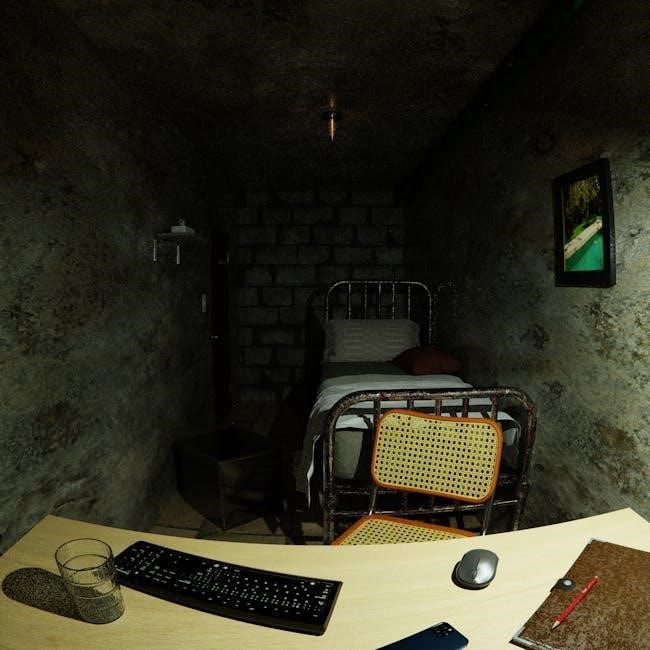Welcome to the comprehensive guide on digital timer manuals. This manual provides detailed instructions for setting up, programming, and troubleshooting digital timers. It covers features, installation, and customization options to optimize your experience.
1.1 Overview of Digital Timer Manuals
Digital timer manuals are essential guides designed to help users understand and utilize their timers effectively. These manuals provide detailed instructions on installation, programming, and troubleshooting, ensuring optimal performance. They cover key features such as LCD displays, memory capacity, and event programming, as well as various operating modes like manual, auto, and random modes. The manuals also highlight energy-saving features and customization options, allowing users to tailor settings to their specific needs. Whether you’re setting up a programmable timer for appliances or configuring advanced schedules, these guides offer step-by-step directions. Additionally, they address maintenance tips and common issues, ensuring longevity and efficiency. By referencing a digital timer manual, users can unlock the full potential of their device and enjoy seamless operation.
1.2 Importance of Reading the Manual
Reading the digital timer manual is crucial for maximizing the device’s functionality and ensuring proper usage. It provides clear instructions on installation, programming, and troubleshooting, helping users avoid common mistakes. The manual explains how to navigate the LCD display, set ON/OFF events, and utilize features like energy-saving modes. Without this knowledge, users may underutilize the timer or encounter operational issues. The manual also offers insights into customization options, allowing users to tailor settings for specific appliances or schedules. Furthermore, it highlights safety precautions and maintenance tips, ensuring the timer operates efficiently and lasts longer. By thoroughly reading the manual, users can harness the full potential of their digital timer, achieving precise control over their devices and optimizing energy usage.

1.3 Brief History of Digital Timers
The evolution of digital timers has transformed how we manage time and control devices. Initially, timers were mechanical, but the advent of digital technology revolutionized their functionality. In the 1960s, mechanical timers were prevalent, but by the 1980s, digital timers began to emerge, offering precision and programmability. The introduction of LCD displays and microprocessors enabled users to set multiple events and customize settings. Modern digital timers now feature advanced capabilities like energy-saving modes, random modes, and smartphone app integration. This progression has made digital timers indispensable in both household and industrial applications, enhancing efficiency and convenience. Understanding their history helps appreciate the technological advancements that have shaped their functionality and user-friendliness today.

Installation and Setup
Plug the digital timer into an electrical outlet and connect your devices. Set programs and configurations as needed. Ensure all connections are secure and properly configured for optimal performance.
2.1 Hardware Requirements for Installation
Ensure you have a compatible electrical outlet to plug in the digital timer. Connect appliances or lights to the timer’s outlets, ensuring they are within the specified power rating. For advanced models, install a backup battery to maintain settings during power outages. Verify compatibility with your devices, such as incandescent lights, motors, or pumps. Some timers require DIN rail mounting, while others are plug-and-play. Use surge protectors for sensitive electronics and ensure the circuit breaker can handle the total load. Always follow safety guidelines to avoid electrical hazards. Refer to the manual for specific voltage and current requirements. Proper hardware setup ensures reliable performance and longevity of the timer. Double-check all connections before powering up the system.
2.2 Software Setup for Digital Timers
Begin by accessing the programming mode on your digital timer. Press the PROGRAM button to start setting up your preferred ON/OFF events. Use the HOUR, MIN, and WEEK buttons to specify the exact time and days for each event. For manual mode, press MANUAL to override programmed settings temporarily. Ensure the timer is in the correct operating mode (ON, AUTO, or OFF) based on your needs. Some models allow syncing with your device’s clock for accuracy. Refer to the manual for advanced features like random or countdown modes. Save your settings to ensure they remain active even after a power outage. Proper software setup ensures smooth operation and customization of your digital timer.
2.3 Placement and Mounting Options
Proper placement and mounting of your digital timer are crucial for optimal performance. Ensure the timer is installed near the device or appliance it will control, such as lamps, air conditioners, or stereo systems. For plug-in models, insert the timer into a grounded electrical outlet and plug your device into the timer’s outlet. DIN rail-mounted timers are ideal for industrial settings and should be securely fastened to the DIN rail. Panel-mounted timers can be installed directly into a wall or control panel for a sleek, integrated look. Always ensure the timer is accessible for easy programming and adjustments. Avoid placing it in areas exposed to moisture or extreme temperatures, as this may damage the internal components. Follow the manufacturer’s guidelines for specific mounting requirements to ensure safe and reliable operation.
2.4 Initial Configuration Steps
To begin using your digital timer, follow these initial configuration steps. First, plug the timer into a grounded electrical outlet and connect your device or appliance to the timer’s outlet. Next, set the current time and date using the HOUR, MIN, and WEEK buttons. Press PROGRAM to enter programming mode and set your desired ON/OFF events. Use the buttons to specify the exact time and day for each event. Once programmed, press SAVE to store your settings. Ensure the timer is in the correct mode (MANUAL, AUTO, or RANDOM) based on your needs. Refer to the manual for specific button functions and mode details. Properly configuring these settings ensures your timer operates accurately and efficiently, providing reliable control over your connected devices.

Features and Functionality
Digital timers offer advanced features like LCD displays, programmable events, and energy-saving modes. They support manual, auto, and random modes, with memory for multiple ON/OFF schedules, ensuring precise control and efficiency.

3.1 Types of Digital Timers
Digital timers come in various types, each designed for specific applications. Plug-in timers are ideal for home appliances, while DIN rail-mounted timers are suited for industrial use. Programmable timers allow setting multiple ON/OFF events, and countdown timers offer simplicity for short-term tasks. Some models feature random modes to simulate occupancy, enhancing security. With options like weekly scheduling and energy-saving features, digital timers cater to diverse needs, ensuring flexibility and convenience. These versatile devices are perfect for automating lighting, HVAC systems, or household appliances, making them essential for modern homes and businesses. By choosing the right type, users can optimize efficiency and streamline daily operations effortlessly.
3.2 LCD Display and User Interface
The LCD display is a key feature of digital timers, providing clear visibility of time, status, and programmed events. Modern timers often include a backlit screen for better readability in low-light conditions. The user interface typically consists of buttons for navigation, programming, and mode selection. Many models feature intuitive controls, such as hour, minute, and week buttons, allowing users to set specific times and days effortlessly. Some advanced timers incorporate touchscreens or capacitive buttons for a seamless experience. The LCD also displays real-time updates, ensuring users stay informed about current settings and operational modes. With a focus on user-friendliness, the interface is designed to simplify programming and daily use, making it accessible for both new and experienced users. This combination of clarity and functionality ensures efficient operation and enhances overall satisfaction with the device.
3.3 Memory Capacity and Event Programming

Digital timers often feature robust memory capacity, allowing users to program multiple events. Many models support up to 28 programmable events, enabling precise control over appliance operation. These events can be set as ON or OFF actions, with specific times and days of the week. Advanced timers may also include weekly schedules, ensuring repetitive tasks are automated effortlessly. The memory storage ensures programmed settings remain intact even during power outages, thanks to internal batteries. This capability is particularly useful for users who need consistent and reliable automation. The event programming process is typically user-friendly, with step-by-step guidance provided in the manual. By leveraging memory capacity and event programming, users can optimize energy efficiency and convenience, making digital timers indispensable for modern households and workplaces.
3.4 Manual, Auto, and Random Modes
Digital timers offer versatile operating modes to cater to different user needs. Manual Mode allows users to override programmed settings, providing instant control over connected devices. This is ideal for temporary adjustments without altering the scheduled events. Auto Mode executes the pre-programmed schedule, ensuring devices operate according to set times and days. For enhanced security, Random Mode introduces variability to ON/OFF events, making it difficult for others to detect patterns in appliance usage. These modes provide flexibility and customization, allowing users to adapt the timer to their lifestyle or security requirements. The manual typically includes detailed instructions for switching between modes and understanding their applications. By utilizing these features, users can achieve greater control over their devices and energy consumption.
3.5 Energy-Saving Features
Digital timers are designed with energy efficiency in mind, offering features that help reduce power consumption. Many models include automatic shut-off capabilities, ensuring devices are turned off when not in use. Some timers also feature smart learning technology, which adapts to usage patterns to optimize energy savings. Additionally, programmable schedules allow users to activate devices only during specific periods, preventing unnecessary power usage. Certain timers offer random mode, which simulates occupancy by randomly turning devices on and off, enhancing security while maintaining energy efficiency. These features not only conserve energy but also lower utility bills. The manual typically provides guidance on enabling and customizing these energy-saving functions to maximize their benefits; By leveraging these capabilities, users can significantly reduce their environmental impact and operational costs.

Programming and Customization
This section explores how to program and customize your digital timer. Learn step-by-step how to set up custom schedules, adjust settings, and tailor the timer to meet your specific needs effectively.
4.1 Step-by-Step Programming Guide

Programming your digital timer involves a straightforward process. Start by pressing the PROGRAM button to access the scheduling mode. Use the HOUR, MIN, and WEEK buttons to set the desired time and day for ON/OFF events. You can program up to 28 events, allowing for precise control over your appliances. After setting the time, press SAVE to store the configuration. For manual overrides, use the MANUAL button to temporarily bypass programmed settings. Ensure the timer is in the correct mode (ON, OFF, or AUTO) before saving. Refer to the digital timer manual PDF for detailed diagrams and additional customization options. This guide ensures your timer operates seamlessly according to your preferences.
4.2 Setting ON/OFF Events
Setting ON/OFF events on your digital timer allows you to automate the operation of connected devices. To set an ON event, press the PROGRAM button, then use the HOUR, MIN, and WEEK buttons to select the desired time and day. Once set, press SAVE to confirm. For an OFF event, repeat the process, ensuring the time is set for when you want the device to turn off. The timer can store up to 28 events, providing flexibility for daily or weekly schedules. Each ON event must have a corresponding OFF event to function properly. After programming, the timer will automatically switch devices on or off at the specified times. Refer to your digital timer manual PDF for detailed instructions and troubleshooting tips.
4.3 Understanding Battery and Power Management
Digital timers often come with internal rechargeable batteries to maintain settings during power outages; Ensure the battery is charged upon initial use or after prolonged disconnection. Most timers operate on volt-free outputs, supporting various power supplies (e.g., 240 Vac to 12 Vdc). To conserve energy, many models feature low-power modes or disable backlights when inactive. Regularly check battery levels and recharge as needed to prevent data loss. Avoid extreme temperatures or physical stress, which can degrade battery performance. Proper power management ensures reliable operation and extends the device’s longevity. For specific battery care instructions, consult your digital timer manual PDF.
4.4 Customizing Timer Settings
Customizing timer settings allows you to tailor the device to your specific needs. Most digital timers offer programmable ON/OFF events, with options for manual, auto, or random modes. Users can set multiple events, such as turning lights on/off at specific times or days of the week. Some models support up to 28 programmable events, providing flexibility for complex schedules. Additionally, override functions enable temporary adjustments without altering saved settings. Customization may also include adjusting display brightness, enabling energy-saving features, or setting up alerts. Refer to your digital timer manual PDF for step-by-step guidance on accessing and modifying these settings. Proper customization ensures efficient operation and maximizes the timer’s functionality for your unique requirements.

Maintenance and Troubleshooting
Regular cleaning and checking the timer ensures optimal performance. Refer to the manual for troubleshooting common issues like power failures or faulty displays. Resetting to factory settings can resolve errors. Proper maintenance extends longevity.
- Clean the timer with a soft cloth to avoid dust buildup.
- Check for firmware updates to ensure the latest features.
- Consult the manual for solutions to specific error codes.
5.1 Cleaning and Maintaining the Timer
Regular maintenance is essential to ensure the longevity and reliability of your digital timer. Start by cleaning the exterior with a soft, dry cloth to remove dust and fingerprints. Avoid using harsh chemicals or liquids, as they may damage the LCD display or internal components. For stubborn marks, lightly dampen the cloth with water, but ensure it is not soaking wet. Gently wipe the buttons and casing, paying attention to crevices where dust tends to accumulate. Avoid exposing the timer to extreme temperatures or moisture, as this can affect its performance. If the timer has a battery, check its condition periodically and replace it as needed. For timers with rechargeable batteries, ensure they are charged properly and stored in a cool, dry place. Regular cleaning and proper care will help maintain the timer’s accuracy and functionality over time.
5.2 Common Issues and Solutions
Some common issues with digital timers include unresponsiveness, incorrect time displays, and battery drainage. If the timer is unresponsive, try resetting it by unplugging and replugging it. For incorrect time displays, ensure the timer is properly synchronized with your time zone and check for any battery issues. If the battery is low, replace or recharge it as needed. Additionally, ensure the timer is clean and free from dust, as dirt can interfere with button functionality. If the timer fails to turn devices on/off, verify that the programming is correct and that all connections are secure. For persistent issues, refer to the troubleshooting section or contact customer support. Regular maintenance and proper care can help prevent these issues and ensure optimal performance over time.
5.3 Resetting the Timer to Factory Settings
To reset your digital timer to its factory settings, follow these steps:
Unplug the timer from the power source.
Press and hold the “PROGRAM” and “HOUR” buttons simultaneously for 10 seconds.
While holding the buttons, plug the timer back into the power outlet.
Release the buttons and wait for the timer to restart.
This process will erase all programmed settings, restoring the timer to its default configuration. Note that all custom events and preferences will be lost, so ensure you have backups or written records of your settings before proceeding. Once reset, the timer will revert to its original factory settings, allowing you to start fresh. If issues persist after resetting, consult the manual or contact customer support for further assistance.
5.4 Best Practices for Longevity
To ensure your digital timer operates efficiently and lasts longer, follow these best practices:
- Clean the timer regularly with a soft, dry cloth to prevent dust buildup, which can interfere with the display or buttons.
- Avoid exposure to moisture or extreme temperatures, as this can damage internal components;
- Use a surge protector to safeguard the timer from power spikes or electrical surges.
- Update firmware periodically if your timer supports it, to benefit from improved features and bug fixes.
- Store backup settings before performing a factory reset or updating software to avoid losing custom configurations;
- Power management is key—use high-quality batteries and avoid overcharging if the timer is battery-powered.
By adhering to these practices, you can extend the lifespan of your digital timer and ensure optimal performance over time.

Resources and Support
Access digital timer manuals, FAQs, and troubleshooting guides online. Download PDF manuals from manufacturer websites or visit forums for community support and additional tutorials.
6.1 Downloading the Digital Timer Manual PDF
To access the digital timer manual, visit the manufacturer’s official website or trusted online repositories. Search for your specific timer model, such as the GE 15079 or Intermatic ST01C. Most manuals are available in PDF format, ensuring easy readability and printing. Follow these steps:
Go to the manufacturer’s support page.
Enter your timer model in the search bar.
Select the appropriate manual from the results;
Download the PDF file to your device.
Ensure you verify the source for authenticity to avoid incorrect or outdated information. Once downloaded, you can refer to the manual offline for setup, programming, and troubleshooting guidance.
6.2 Online Forums and Community Support
Online forums and community support are invaluable resources for troubleshooting and understanding your digital timer. Platforms like Reddit, specialized electronics forums, and manufacturer-hosted communities offer a wealth of knowledge. Users often share their experiences, solutions, and tips for resolving common issues. For example, discussions about programming errors, timer modes, and compatibility with specific appliances are frequent. These forums also provide access to unofficial guides and workarounds that may not be covered in the official manual; Many users report finding solutions to problems like incorrect time displays or failed programming by consulting these communities. Additionally, forums often include real-world applications and creative uses for digital timers, helping you maximize their functionality. If you encounter an issue not addressed in the manual, online forums can be a reliable next step for finding answers.
6.3 Manufacturer Customer Service
Manufacturer customer service is a crucial resource for addressing specific queries or issues with your digital timer. Most manufacturers provide dedicated support through their official websites, offering detailed FAQs, troubleshooting guides, and downloadable resources like the digital timer manual PDF. Many companies also offer direct contact options, such as phone support or email, for personalized assistance. For example, brands like Intermatic and GE provide comprehensive customer service portals where users can access product-specific information, repair guides, and warranty details. Additionally, some manufacturers host live chat services or forums where experts can help resolve complex issues. Always refer to the official website for the most reliable and up-to-date support, ensuring your digital timer operates efficiently and effectively. These resources are designed to enhance your user experience and provide solutions tailored to your needs.
6.4 Additional Guides and Tutorials
Beyond the digital timer manual PDF, additional guides and tutorials are available to enhance your understanding and usage of the device. Many manufacturers provide supplementary resources, such as video tutorials, step-by-step installation guides, and advanced programming tips. These materials can be found on the manufacturer’s official website or through their customer support portals. Online forums and community discussions often feature user-generated content, offering practical advice and troubleshooting solutions. Some brands also offer interactive guides or webinars to help users maximize their timer’s functionality. These additional resources are invaluable for mastering complex features, resolving common issues, and exploring customization options. By leveraging these tools, users can ensure optimal performance and extend the longevity of their digital timer.
This concludes the comprehensive guide to understanding and utilizing your digital timer manual PDF. From installation and setup to advanced features, troubleshooting, and maintenance, this manual equips you with essential knowledge for optimal performance and longevity. Consistent practice and exploring additional resources will further enhance your experience with digital timers.
7.1 Summary of Key Points
This manual provides a comprehensive guide to digital timers, covering installation, programming, and troubleshooting. It emphasizes understanding features like scheduling, energy-saving modes, and manual overrides. Troubleshooting tips and maintenance practices ensure longevity. The importance of reading the manual for optimal functionality is highlighted, along with resources for additional support. By following the instructions, users can maximize their digital timer’s performance and efficiency, ensuring seamless operation for various applications. This guide serves as a valuable resource for both beginners and experienced users, offering clear, step-by-step instructions and expert advice for every scenario.
